MATT GUNDRY
Flying Eagles Ski Club
Eau Claire, WI
Curator’s Note-
This is a long story with many photos and I want to first thank Matt for pulling it all together- amazing job! This very long piece is a divergence from the typical Story Project post but I think the accomplishment is so grand and the inspiration (and information!) so priceless that it’s important to share (and record for posterity) the “all” of it. So here it is-
This is the story about a small, but dedicated, club and an enormous undertaking. As many know, Flying Eagles Ski Club in Eau Claire, Wisconsin is in the midst of one of their largest projects to date – completion of an entirely new FIS-homologated HS55 ski jump designed to the latest standards. Much like learning the sport of ski jumping itself, developing a project of this scope with the limited resources of a small youth sports club is a seemingly endless series of challenges and rewards…and at some point it demands that leap of faith. That said, the club is reasonably confident that the first jumps are mere months away, and so it is hoped that a little story telling won’t jinx completion.
We will preface the story with some clichéd bits of project development wisdom. Many probably apply, but two have been stated repeatedly over the course of construction and are as true at the end of the project as they were at the beginning. The first was the answer to the question “How does a small group of volunteers take on a project of this size?” The answer (with apologies to those who avoid animal products) is “The same way you eat an elephant: one small bite at a time.”
The second is a little less cheesy: “Cost. Quality. Expediency. Pick two.” You can have a relatively low cost project with high quality, but it will take longer to complete. You can have a high quality project completed quickly, but it will be more expensive. Or you can have a project completed quickly and inexpensively, but the quality will suffer. Our budget is still in reasonably good shape (estimating the final cost will be 30 cents on the dollar when compared to a traditionally contracted project) and the jump looks amazing (in my not-so-humble opinion)…but it has been over 3 years of construction in the making. That’s option #1 if you were paying attention.
On to the story:
FESC had been considering replacement of the 40m hill at Mt. Washington for years. It seemed financially out of reach until in 2016 a former athlete and his wife, Jerry and Nancy Severson, made a very generous donation to the club. This spurred development of conceptual designs followed by the Flight into the Future fundraising campaign (check out the great video on YouTube) led by member Paul Seipel, guided by former national team member Scott Lubansky, and supported by Paul Kohler of Charter Bank (a major donor) that more than doubled the initial Severson donation. In the end, many area businesses and individuals contributed both in-kind and monetary donations with several meeting or exceeding $100,000. It bears emphasizing that the large 6-figure Severson donation was the financial foundation this project needed and without which this project would be inconceivable.
In 2017 new jump plans and homologation drawings were prepared by Matt Gundry and submitted to FIS for approval. Then the first setback came – those plans came to FIS just as they were revamping hill design standards. Rather than apply the 2012 standards, FIS wanted a number of changes to comply with the yet-to-be-released 2018 standards – changes that not only required complete redesign of the grading and tower, but increased the expense. The club was assured that the changes would be well worth the effort, and so a months-long delay ensued for design revisions. Finally in late Fall of 2017, FESC awarded the first two construction contracts: landing hill grading (A-1 Excavating) and retaining wall construction (Green Oasis) to separate the HS55 knoll from the nearby 30m in run.

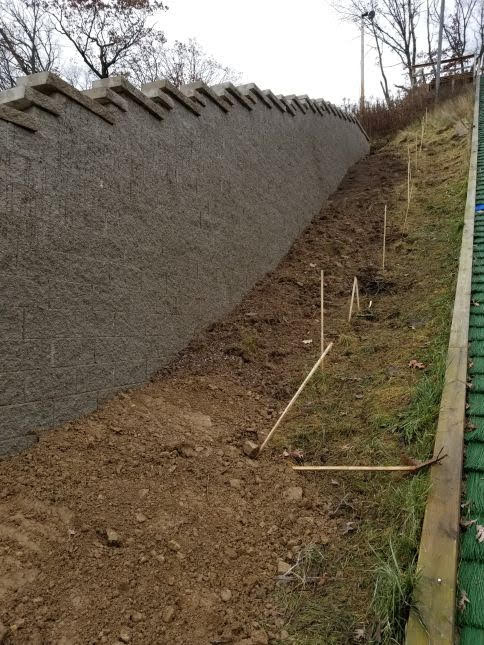
In the spring of 2018, the club began the first large scale volunteer construction effort of the project, paving the landing with reinforced concrete. This was led by long-time club members and experienced contractors Dave Tomten and Pat Hamler. They developed an innovative application of snow grooming equipment to the task of fine grading: using the snow cat winch to assist the skid steer fine grooming the subbase before placing the reinforced concrete. June and July are peak thunderstorm season in Wisconsin, and they got lots of practice re-grading the slope after each storm until the concrete could finally be placed.

When local contractors declined to bid the work or even told the club that paving the landing wasn’t even feasible, these two former national-level jumping athletes showed true determination to lead a large group of volunteers to set forms, tie rebar, and finish concrete on a 35 degree slope in 100 degree weather. Fortunately local concrete supplier American Materials gave the club a large break on the cost for both the landing and the tower. Here are Pat and Dave in the middle of the fray, with two of the clubs most dependable volunteers, Dan Wold and Don Dahl, not far behind. The local police stepped in as well, with club member and Deputy Chief Chad Hoyard bringing in volunteers from the department to help out. Many of the remaining people in the picture are community volunteers with no direct connection to the ski club.

Unfortunately it was during the concrete pour that the first real (and hopefully only) casualty occurred. Jr. athlete Stewart Gundry and stalwart volunteer Rolf Sorenson happened to be standing in the blast zone when partially hardened concrete in the concrete pump hose unexpectedly let go under high pressure. It knocked both of them downhill. Rolf is more mountain than man, and took the hit in stride – very fast strides down the landing in fact. Stewart, however, had the wiry build of someone born to fly. And fly he did. Unfortunately he landed with his shoulder on the formwork and covered head to foot with concrete. We cleaned the concrete off him inside the clubhouse, but not before chemical burns set in. Although he was pretty sore, he walked it off and was back out watching the work later in the afternoon. Following a week at summer camp, Stewart was off to the first Fly Guys at Steamboat following the incident. Unbeknownst to us, he was more than just bruised and had actually broken his shoulder in two places. This was not discovered until he had a precautionary X-ray in Steamboat. Unfortunately he missed the rest of that first Fly Guys, though he did go back the following year. He has also returned to help at the hill numerous weekends – if he holds anything against the old man he hasn’t let on yet.
With the hill paved, volunteers as well as hired hands by the Mattoon and Urlaub families spent the remainder of the year stabilizing the slopes. Athlete families including the Lees, Pauls, and Gorskis pitched in carrying topsoil by the 5 gallon bucket into areas inaccessible by equipment. Local linemen students attending Chippewa Valley Technical College under the tutelage of Bandi Henke learned how to set power and light poles in very difficult conditions, donating time and equipment to the task. It was also time to award a contract for the tower main structure…and encounter the next setback. The contractor we had been working with to vet the constructability of the tower came in with a bid that eclipsed the budget for the entire project. The project stalled for several months. After speaking with numerous other contractors we were finally able to negotiate a workable price with another local bridge contractor, Larson Construction, and tower work began in the fall of 2018. Volunteers continued to participate to reduce the contractor costs by tying rebar and other tasks. Here you see Don Dahl feeding rebar to Dan Wold, while Pat Hamler, Chad Hoyord, Zach Jastrow, and Jhan Cowles tie the bars in place that connect the big footing to the big pier.
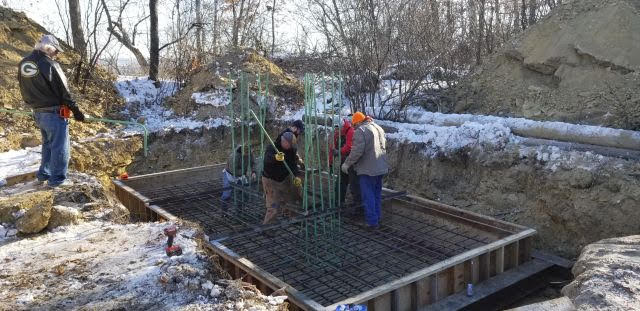
Work continued on the tower through the winter of 2018-2019.


In early 2019 a major milestone was reached when the primary steel framework was set. The steel girders and cross bracing were fully assembled on the ground, then set on the piers with two cranes. In a matter of 15 minutes, the City of Eau Claire western skyline changed dramatically.

Anyone in the area that didn’t know about the Mt. Washington “Eagles Center” ski jump training facility before, knew about it now.

With the heavy structural work complete, it was time to start on the deck. This was volunteer work again, framing galvanized steel joists and stairs, and installing FRP grate decking. Here are Don Dahl, Paul Jastrow, Dan Wold,and Eli Gundry after finishing up framing and installing the tower access stairway. Gotta have faith in your work.

Eli and Tele the puppy, maybe working on those telemark/Red Wing landings. Careful near that edge! Dave Tomten worked with a local high school shop class to mass produce the hundreds of cable rail posts which now protect the edges of the stairs and starts.
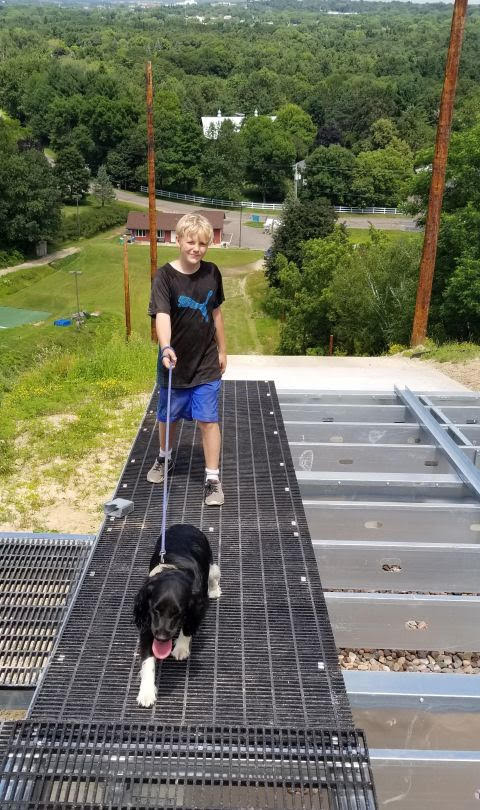
Although volunteers worked nearly every Saturday from spring thru fall of 2019, progress was slow. Installing all that decking was tedious, and really strained the club volunteer resources. At the end of the 2019 season, we hadn’t even reached the big steel frame. Many members began to be concerned that if work continued at the slow pace, it would be 2022 or later before the first athletes would ski off the jump.
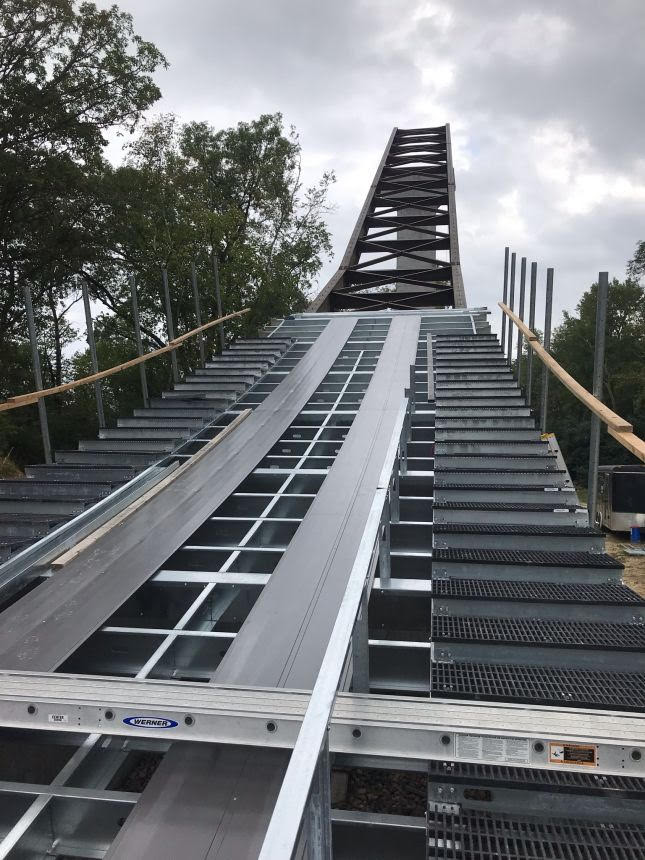
In winter 2019-2020, Dan Mattoon searched out help once again from local contractors. This time Market and Johnson stepped up. In early spring of 2020, they began working with the local carpenters union to pre assemble the deck into panels. After about 2 weeks of prep work to the tower steel from a boom lift, Market and Johnson brought in the crane.
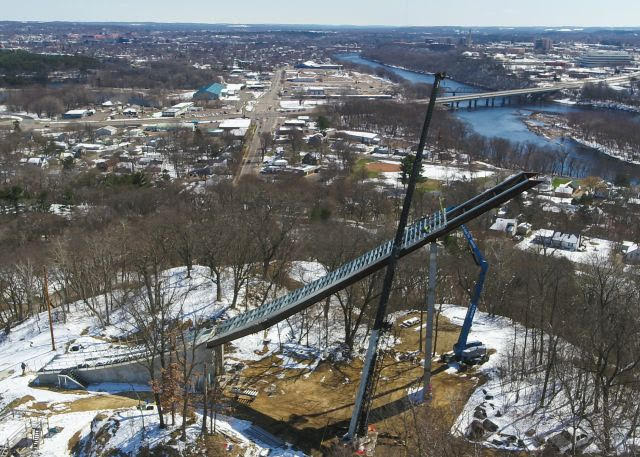
In one day they were able to set all the remaining deck panels (about 150′ of inrun) to the top of the tower. Being the exception that proves the rule (Cost, Quality, Expediency), in one day Market and Johnson completed work that would have taken volunteers another year, they did excellent work, and best of all they apparently forgot a zero in their invoice.
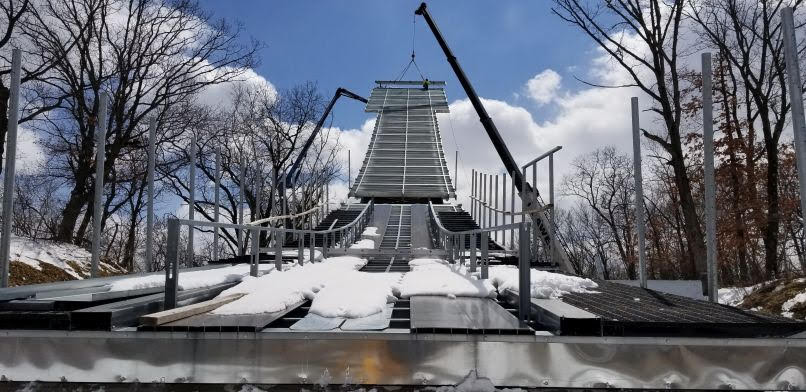
This leap in progress visibly invigorated the volunteers, and through the spring, summer, and fall of 2020, enormous progress was made with all the stairs, start platforms, railings, and in run decking installed. Peter Misurek, Nathan Kuehl, Dan Wold, and Pat Hamler were Saturday regulars on the top of the tower in their fall-arrest gear with Jastrows Mike and Zach pitching in on much of the framing. Gundry brothers Logan and Stewart and fellow athletes Hayden and Turner worked alongside Lang Jacobson, Don Dahl, Nathan Kuehl, and Trace Miller getting the rubber underlayment and plastic installed, cable railing threaded, and deflection board facing installed. Mattoon and Urlaub families continued to provide hired hands that worked through the week to keep the project moving forward. Meanwhile at the end of the outrun, Dave Tomten was leading overachievers Dan, Pat, and Don with constructing a retaining wall and outrun side-protection components that would keep the athletes and spectators safe on the outrun. Former jumper Gary Amundson helped get his employer Push Inc. to bore in the new compressed air and water lines for snowmaking, and Jeff Urlaub worked with plumbing contractors to get those lines connected to the existing pump and water cooler system his company designed. Lisa Mattoon kept the contractors and suppliers paid and helped ensure that the budget was not forgotten. Many other club members stepped in as well, helping install plastic during jumping practice, cutting and preparing parts in evenings after work, providing lunches on work days, and cleaning up the clubhouse which was often left a bit messy after workdays. We even had Mike LeBlanc from Duluth volunteer, travelling hundreds of miles to help build retaining wall and install the rubber underlayment he had procured for the club. These weren’t all experienced contractors; we had chefs, nurses, doctors, IT professionals, bankers, flight attendants, dentals techs, firemen, policemen, and others willing to step outside their comfort zone.
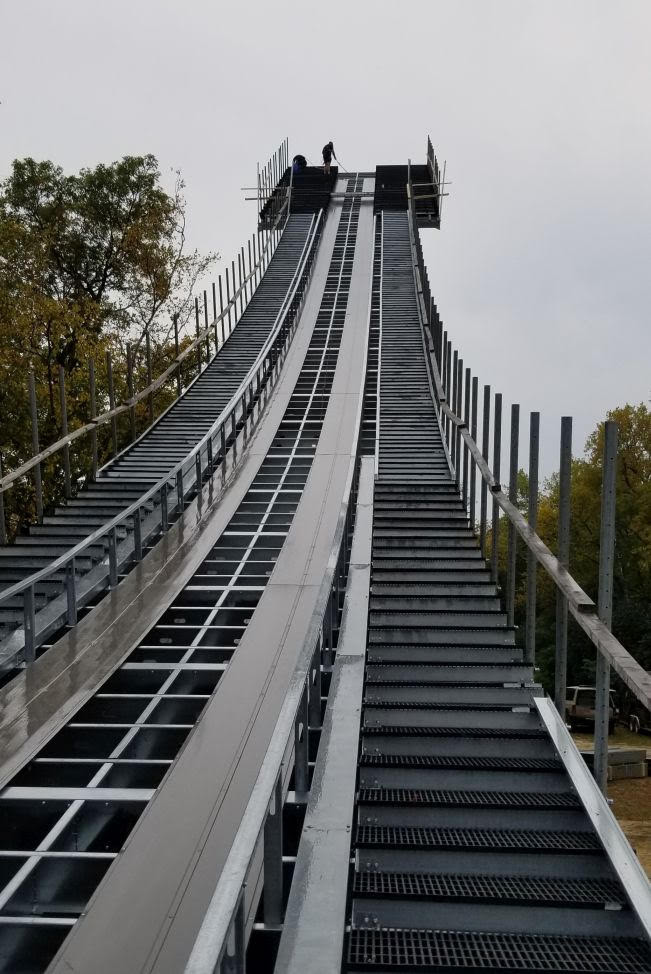
At this time in mid-December 2020, we have finally installed most of the snow netting. Lights are getting installed on the poles, and we are now turning thoughts to installing the tracks and making snow. We are cautiously optimistic that we will soon know if that new jump flies as well as we all hope it will.

NOTE FROM MATT-
Sorry for the length – sort of bucking the trend this year of shorter stories and more photos. But it has been a long project – you get a long story and maybe enough pics to keep it interesting. We hope it instills confidence for the many other clubs considering their own capital improvements. There is probably more business and community support than you realize if you just know where to look. Even more than that, though, we hope it reinforces the importance of members and parents stepping up and pitching in when your club does take on a project, whether that is building a new jump, constructing a new clubhouse, or snowing an inrun. If you don’t, you are the one missing out. Recall above that we estimate this jump will cost about 30 cents on the dollar. That means the other 70 cents were made up in some way or another by volunteers and in-kind donations. When you consider the enormity of the Severson and other monetary donations that kicked this project into gear, that volunteer contribution is simply staggering. Although none of the volunteers named above would deny that the HS55 project has been arduous and demanding (engineers are ever so picky), it is certain that they would say their involvement was also very rewarding. We know that as project leads, we are incredibly proud of the accomplishment and grateful for the sacrifice.
Matt Gundry, Project Engineer/Manager
Dan Mattoon, Project Leader

|
1 Comment
I tip my hat to you guys. Accomplishing this is something to be very proud of. Taking on a project like this take a lot of guts and determination. Well done!